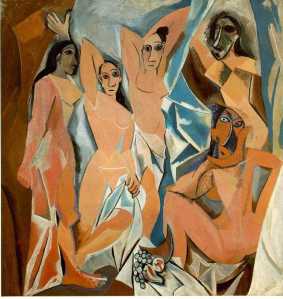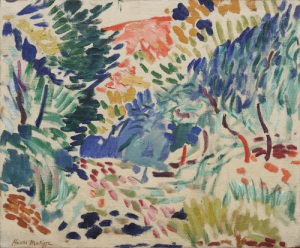The sixth issue of Poetry, published in 1913, features two articles about a burgeoning literary movement called Imagism. One was written by F.S. Flint, and the other by Ezra Pound. The two pieces generally agree with one another, with Pound’s contribution reading like an insider’s expansion on Flint’s more basic observations. Both state the major tenets of Imagism to be economy of language, direct treatment of things, minimal abstraction, and in terms of meter, to write in the manner of a musical phrase as opposed to a metronome.
Pound and Flint were commenting on the Imagistic movement away from wordiness and excessive authorial interpretation. The Imagists wanted to create an picture in the mind of a reader that would speak for itself; in a sense, they wanted to show, simply, rather than tell their readers what was happening in their poems, and allow the reader to react to their words organically. Imagist theory carried on through to writers of the Beat Generation such as Hart Crane, Allan Ginsberg and William Carlos Williams, a prime example of Imagist writing being the latter’s (in)famous short poem “The Red Wheelbarrow.” But how does Imagism relate to art? More specifically, how does the literary theory of Imagism relate to the theories of modern art that were sweeping Europe at the same time?
Modernist artists and Imagist poets both de-emphasized mastery, in a classical sense at least. The Imagists shed rigid rules of meter and rhyme as modern artists shed rules of composition and symmetry. Both stressed a return to the everyday; what is likely Pound’s most famous poem is, ostensibly, about the simple, quiet moment of perceiving faces in the metro, and the subjects of Picasso’s Les Demoiselles D’Avignon (below) are prostitutes. Both strove to elevate the everyday experience through new treatment. Modern painters no longer aimed to realistically represent a landscape or the human form (see Demoiselles and Matisse’s Landscape at Collioure below), just as Imagist poets no longer yearned to describe their feelings but rather denote, or connote, them. Art became about conveying the feeling of perception rather than accurately representing the perception itself. This concept is mirrored in a comment from Pound wherein he condemns literary description: “When Shakespeare talks of the ‘Dawn in russet mantle clad’ he presents something which the painter does not present. There is in this line of his nothing that one can call description; he presents” (Poetry 1.6, 203). The painter Pound refers to in this passage must be a painter in the classical sense of one who represents an image as it appears to the eye, because he is suggesting that Shakespeare’s words add something to the painted presentation that simple artistic mimesis lacks. He is writing about that moment of connotation, of recognition in the mind of a significance or poignancy, be it represented in poetry or in modernist art, which requires no authorial or artistic mediation for readers’ personal comprehension.
At first glance it might seem that the Imagist’s dislike for abstraction would prevent congruence between that movement and the undeniably abstract modern art movement, but one must keep in mind the difference between linguistic and visual abstraction. In terms of language, abstraction serves to tell a reader what a concrete item means, or what the author wants a reader to think about or feel while considering it. It is a sort of description. In visual art, however, abstraction does quite the opposite. Instead of telling you what to feel about a particular concrete image or object abstraction takes you away from its reality and allows for an utterly new and unique consideration of the object presented. Where in poetry abstract language tells the reader how to perceive, in visual art, abstraction liberates and gives the viewer a new freedom of perception.
Modern art and Imagist poetry almost simultaneously conceived of a new version of beauty, and a new method of perception. Both move to free their readers (or viewers) by moving away from rigidly composed works that tell rather than show. In poetry, showing happens by minimizing abstraction and emphasizing simplicity. In art, the opposite must occur, because simply representing an object as it appears in reality leaves less room for individual connotation and experience of perception.
Works Cited
Poetry: A Magazine of Verse. Vol. 1 Iss. 6. 1913: 203. Web. 08 Feb. 2012. <http://dl.lib.brown.edu/pdfs/1201897921671875.pdf>

